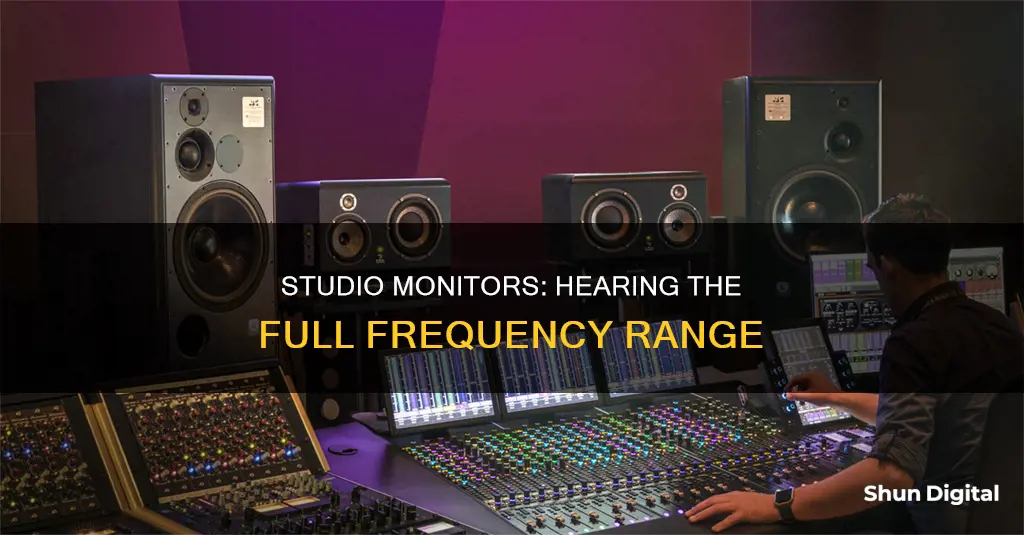
Studio monitors are speakers designed for use in recording studios, radio stations, and other professional audio environments. They are used to mix music, dialogue, and sound effects during the recording, mixing, and mastering processes. Unlike regular speakers, studio monitors have a flat frequency response, meaning all frequencies are played at the same volume level. This flat frequency response is crucial for accurate mixing and mastering, ensuring that the mix will sound good on various playback systems, from high-end stereos to car radios, earbuds, and smartphones.
The frequency response of a studio monitor defines its bandwidth, or the range of audio frequencies it can reproduce. While most studio monitors can replicate frequencies up to an almost inaudible 20kHz, they differ in how low they can go. The driver size is responsible for this difference, with larger drivers capable of reproducing lower frequencies. Nearfield studio monitors, for example, typically have drivers ranging from 4 to 6.5 inches, resulting in limited low-end replication, usually down to about 50-75Hz.
When choosing studio monitors, it is essential to consider the frequency response specifications and limits, as these will impact the accuracy of the sound reproduction. Additionally, factors such as room size, budget, and intended use should be taken into account to ensure optimal sound quality and mixing experience.
| Characteristics | Values |
|---|---|
| Frequency range | 20Hz – 20kHz |
| Speaker configuration | 2-way, 2.5-way, 3-way |
| Driver size | 4", 4.5", 5", 6", 6.5", 7", 8" |
| Tweeter type | Ribbon, silk dome, soft dome, kevlar, beryllium |
| Inputs | XLR, RCA, TRS, TS, USB, etc. |
| Digital connectivity | Yes/No |
| Amplifier | Active/passive |
What You'll Learn
- The human ear can perceive frequencies as low as 20Hz and can feel lower frequencies
- Most studio monitors don't go below 30Hz
- Active monitors have built-in amplifiers and are simpler to use
- Passive monitors require external amplifiers and offer more flexibility
- The size of studio monitors depends on room size and music style

The human ear can perceive frequencies as low as 20Hz and can feel lower frequencies
The human ear is a highly efficient transducer, converting sound pressure in the air into a neural-electrical signal that is interpreted by the brain as speech, music, noise, etc. The ear can detect a wide range of sound frequencies, from very low bass to high-pitched tones.
The human ear can perceive frequencies as low as 20 Hz, and some suggest that we can "feel" frequencies lower than this. This is because the ear can only localise sounds above a certain frequency, and so lower frequencies are perceived through bodily sensation rather than directional hearing.
The ability to perceive low-frequency sounds is important for several reasons. Firstly, it allows us to locate the source of a sound, as the ear can determine the direction of sounds above a certain frequency. This is particularly useful for identifying the position of a car based on the sound it produces, for example. Secondly, it helps us to distinguish between different sounds, as the ear can detect small changes in sound frequency. For instance, the ear can differentiate between a 50 dB SPL sound and a 51 dB SPL sound. Finally, it enables us to identify and recognise different sound sources, even when multiple sources are present at the same time. This is known as auditory scene analysis, and it is why we can understand speech and music, and identify individual sounds in a noisy environment, like a cocktail party.
The perception of low-frequency sounds is also important for music production. Studio monitors with a frequency response below 30 Hz can be beneficial for producers who want to be able to hear and feel the lower frequencies in their music. However, most studio monitors don't go below 30 Hz, and introducing a sub into the mix can be complicated and expensive. Additionally, the wavelengths of very low frequencies may be longer than the dimensions of the room, which can cause issues with sound reflection and distortion.
In summary, the human ear can perceive frequencies as low as 20 Hz, and we may be able to feel frequencies lower than this due to the way low-frequency sound waves interact with our bodies. The perception of low-frequency sounds is important for sound localisation, discrimination, and identification, and it plays a crucial role in our everyday lives and in specialised fields like music production.
Blind Spot Monitor: Toyota's Worthy Safety Investment
You may want to see also

Most studio monitors don't go below 30Hz
Studio monitors are designed to have a flat frequency response, meaning that all frequencies are played at the same volume level. This is important for accurately balancing the levels of different frequencies in the audio, which is crucial when mixing. Studio monitors are used to mix music, dialogue, and sound effects during the recording, mixing, and mastering process.
While most studio monitors don't go below 30Hz, some high-end models can reproduce frequencies as low as 20Hz. However, these monitors are typically very expensive and require a large space to function properly. For example, the Barefoot Sound MiniMain12 monitors, which can reproduce frequencies down to 20Hz, cost around $23,000.
Instead of investing in expensive monitors that reproduce very low frequencies, some people choose to use subwoofers in conjunction with their studio monitors. Subwoofers can provide more accurate low-end reproduction and enhance the overall listening experience. However, introducing a subwoofer into the mix can also complicate the setup and may not be necessary for most users.
In conclusion, while it is possible to find studio monitors that go below 30Hz, they are typically more expensive and may not be worth the investment for most users. The majority of studio monitors don't go below 30Hz, and this is due to a combination of technical, financial, and spatial constraints.
Resetting TFT LCD Monitors: A Step-by-Step Guide
You may want to see also

Active monitors have built-in amplifiers and are simpler to use
Studio monitors are an essential component of the mixing process, allowing producers to hear their tracks in intricate detail and make informed decisions when applying EQ, compression, and other sound manipulation techniques.
Active studio monitors have built-in amplifiers, making them simpler to use than passive monitors. This all-in-one solution streamlines the setup process, as they are designed to offer a cohesive sound experience straight out of the box. Active monitors are also known as powered studio monitors, and they can enhance synergy between the amplifier and speakers for optimal performance. The built-in amplifiers are tailored to the speakers, optimising sound quality.
The bi-amp configuration, where each driver has its own dedicated amplifier, is often used in active monitors to provide better control over frequency response and more precise sound reproduction. This setup is particularly useful in professional studios where accuracy and detail are of utmost importance.
In contrast, passive monitors require an external power amplifier and offer more flexibility in terms of customisation. With passive monitors, users can select and upgrade their amplifier and speakers separately, allowing for a tailored approach to their sound system.
When choosing between active and passive studio monitors, it's essential to consider your specific needs, budget, and space constraints. Active monitors are generally more convenient and reliable, while passive monitors offer greater customisability.
Finding Monitor Dimensions: A Quick Guide to Measure
You may want to see also

Passive monitors require external amplifiers and offer more flexibility
Studio monitors are an essential component of the mixing process, allowing you to hear your tracks in intricate detail and make informed decisions when applying EQ, compression, and other sound manipulation techniques. When setting up a studio, one of the key decisions you'll face is choosing between active and passive studio monitors.
Passive monitors require external amplifiers, offering more flexibility in customising your setup. This gives you the freedom to create your ideal signal chain by choosing your amplifier, crossover system, and other processing equipment. You can easily try out different amplifiers, crossovers, speaker cables, and processors to find the combination that yields the best performance for your setup. This makes passive monitors ideal for surround and immersive monitoring setups, where you can mount multiple lightweight speakers from walls and ceilings, controlling them all with a single amplifier.
Passive monitors are also advantageous if you want consistency in your setup. Since temperature, humidity, and power fluctuations can cause amplifiers to perform differently, it's better to have one or two amplifiers serving multiple speakers rather than having an amplifier in each speaker. This is especially important in critical listening disciplines like mastering.
Additionally, passive monitors make it easier to expand your setup as your studio grows. You can start with a stereo pair of monitors and a four-channel amp, then add more monitors and amp channels as needed for larger setups. This modular approach can be more affordable than investing in multiple active monitors and allows you to upgrade components one at a time.
While passive monitors offer flexibility and customisability, they do require more research, planning, and installation time. They also require careful consideration of power ratings and impedance levels to ensure optimal performance.
Finding the Calendar: A Quick Guide to Locating It on Your Monitor
You may want to see also

The size of studio monitors depends on room size and music style
The size of studio monitors you need depends on the size of your room and the style of music you're working on.
If you have a small room, you'll need smaller studio monitors. As a general rule, the bigger the monitor, the larger the room should be. If your room is higher than 4x4x2.5m, 8" monitors will be suitable. A room that's 5x5x3m in size is perfect for 8" monitors. If you don't have access to a big room, 5" monitors are a good option.
The style of music you produce will also determine the size of the studio monitors you need. For genres like dance or hip-hop, where low-end frequencies are important, you'll need at least 6" speakers, though larger would be ideal. If you're a singer or guitarist, smaller speakers will suffice as you won't be generating very low bass frequencies. 5" monitors, or even smaller, will be fine.
Additionally, the size of the woofer, or the largest driver, will determine the bass response of the studio monitor. The larger the woofer, the lower the bass it can reproduce. However, a larger woofer will require a bigger room to hear the bass accurately.
When choosing the size of your studio monitors, it's crucial to consider both the room size and the music style to ensure optimal sound quality and accuracy.
Regarding frequency range, studio monitors should have a flat frequency response, meaning all frequencies are played at the same volume level. This is important for accurately balancing the levels of different frequencies during the mixing process.
BenQ Monitor: Worth the Investment?
You may want to see also
Frequently asked questions
The frequency range of a studio monitor is important as it defines the monitor's bandwidth, or the range of audio frequencies the monitor can reproduce. The human ear can typically perceive frequencies as low as 20Hz and up to 20kHz. Studio monitors should aim to have a flat frequency response, meaning all frequencies are played at the same volume level, to ensure accurate mixing and mastering.
The ideal frequency response for a studio monitor will depend on the specific application and room size. A wider frequency response is generally better, as it allows the monitor to deliver a fuller range of highs and lows. However, it is important to consider the limits of the frequency response specification, as these define how much quieter the monitor will be at its minimum and maximum frequencies. For example, a monitor with a frequency response of 20Hz to 20kHz @ -3dB will be quieter at the minimum and maximum frequencies than a monitor with a response of 20Hz to 20kHz @ -10dB.
Active studio monitors have built-in amplifiers, while passive studio monitors require external amplifiers. Active monitors are generally easier to set up and use, while passive monitors offer more flexibility in terms of amplifier choice.







